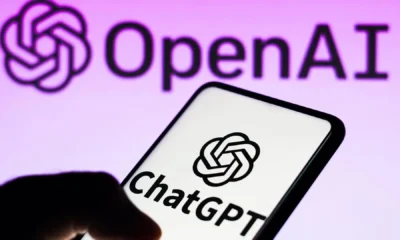News
Power, Orbit and Intelligence: Why the Push for Super‑AI is Triggering a Space‑Bound Data Center Race

- Share
- Tweet /data/web/virtuals/375883/virtual/www/domains/spaisee.com/wp-content/plugins/mvp-social-buttons/mvp-social-buttons.php on line 63
https://spaisee.com/wp-content/uploads/2025/11/space_data_center-1000x600.png&description=Power, Orbit and Intelligence: Why the Push for Super‑AI is Triggering a Space‑Bound Data Center Race', 'pinterestShare', 'width=750,height=350'); return false;" title="Pin This Post">
As the hunger for artificial intelligence grows exponentially, delivering “super‑intelligence” no longer means simply building bigger chips or better models. It now means building massive infrastructure: enormous data centers, near‑unlimited energy sources and, increasingly, entire compute facilities launched into orbit. Two of the biggest players in tech—Google LLC and Nvidia Corporation—are leading this shift. Their bold concept: send data centers into space, powered by 24‑hour solar energy, to overcome the limits of Earth‑based compute and energy supply.
The Constraint: Energy and Data Centers
For years, progress in AI has been driven by chips, algorithms and data. Today it’s being held back by infrastructure: especially energy, cooling, space and water. Earth‑based data centers consume vast amounts of electricity and require immense cooling systems and real estate. Without enough power and efficient thermal management, the next generation of model training and inference becomes prohibitively expensive or simply unfeasible. Analysts estimate that by 2030 the world’s computing infrastructure could require electricity on the scale of a major nation.
In this context, AI firms are realising that the limiting factor may not be the number of models or size of datasets—but the ability to build and power the data centers that run them. It’s not just about hardware; it’s about having the facility, energy and cooling systems that can sustain an era of continual, large‑scale AI training and inference.
Enter Orbit: Data Centers Beyond Earth
The answer some tech strategists are converging on is radical: placing data centers into space. Google’s “Project Suncatcher” outlines a plan to launch satellites equipped with Tensor Processing Units (TPUs) and solar arrays into low Earth orbit. These satellites would operate in continuous sunlight, harnessing solar energy more efficiently than on Earth by avoiding atmospheric loss and nighttime constraints. Google documents report efficiencies up to eight times greater than mid‑latitude ground installations.
Nvidia, through its work with the startup Starcloud, is pursuing a parallel path. Starcloud plans to launch the H100 GPU into orbit via the Starcloud‑1 satellite—a 60‑kg platform slated for late 2025. According to reports, this represents the first time a data‑center‑class GPU will operate in space, and the company estimates energy cost reductions of up to ten‑fold compared to Earth‑based compute. These efforts mark a tangible shift from concept to prototype for orbiting AI infrastructure.
Why Space Makes Sense
There are several compelling reasons for this leap. First, solar energy in orbit is unfiltered by atmosphere and nearly continuous (in certain orbits), meaning far more power per panel than ground‑based systems. Second, space offers a natural heat sink: in vacuum, heat can be radiated directly into cold space, reducing or eliminating large cooling systems and water usage. Third, launch costs are plummeting, thanks to reusable rockets and economies of scale, making previously absurd ideas more plausible.
In effect, placing data centers in space allows AI‑infrastructure builders to escape terrestrial bottlenecks: limited power capacity, water scarcity, land constraints and cooling complexity. It becomes less about “how many chips can we place in a rack” and more about “how many compute megawatts can we orbit and power via sunlight.”
The Engineering and Economic Hurdles
Despite the appeal, the road is far from smooth. Operating compute hardware in orbit presents new challenges: radiation exposure which can cause bit‑flips or hardware degradation, high‑bandwidth inter‑satellite communications to mimic data‑center fabric, thermal management beyond Earth’s convection cooling, and the sheer logistical complexity of servicing or replacing modules once launched.
Google’s own research paper cautions that although no insurmountable physics stand in the way, many engineering and economic obstacles remain. In particular, achieving ground‑to‑orbit data links at terabit per second speeds and maintaining reliable operations in an orbital environment are open questions. Launch costs still matter: although they may fall substantially by mid‑2030s, currently they represent a major expenditure.
Moreover, even if launch costs drop to the projected $150‑$200 per kilogram, the overall cost of building, operating and servicing an orbital data center must match or beat Earth‑based economics and reliability. By some models, parity might arrive by the mid‑2030s—but until then this remains a moonshot, albeit one that is now backed by real prototypes.
Strategic Implications for Companies and AI
If this vision succeeds, the implications are profound. For companies like Google and Nvidia, successful orbital compute would unlock virtually limitless scaling: compute isn’t constrained by local grids, cooling infrastructure or real‑estate availability. It changes the business model of AI from “chip and rack” expansion to “constellation and sunlight” expansion.
It also realigns competition: firms that can build or access low‑cost compute in orbit will have a differentiated advantage in training massive models or running real‑time inference at unprecedented scale. Where previously the race was about chips, now it will also be about infrastructure, energy supply, and orbital logistics.
For the AI ecosystem more broadly, this shift highlights a new frontier: delivering not just smarter algorithms, but smarter infrastructure. Achieving super‑intelligence will not just be about architecture, but about having the right data centers built, the energy supply secured, and compute scaled beyond Earth’s constraints.
A Broader Perspective: Earth, Ethics and Access
This movement also raises broader questions. What does it mean when the biggest compute platforms are beyond national jurisdiction, orbiting Earth? How will access to orbital compute be governed? What about the environmental impact of launches, the potential space debris risk, or the inequality in access when only a few corporations can afford orbiting data centers?
There is an irony at play: moving data centers to space may reduce terrestrial energy and cooling demands, but it shifts environmental cost to rocket launches and adds new dependencies in space logistics. And on the question of global access, will orbiting compute further concentrate power in the hands of a few, or open up new models where compute becomes globally available but abstracted?
Conclusion: From Chips to Constellations
As AI moves from big‑model experiments to infrastructure escalation, the question of scaling is not just “how many parameters” but “where will we run them”. The push by Google, Nvidia and others to orbit‑bound data centers signals that delivering super‑intelligence is about far more than algorithmic innovation. It’s about building the data centers, securing the energy, and overcoming physical constraints of Earth. If today’s leading AI firms can turn this aspiration into reality, the next frontier of intelligence may be literally among the stars.
News
Jeff Bezos Returns to the Helm: Co‑CEO Role at Project Prometheus Signals AI’s Next Industrial Wave

After stepping back from frontline leadership at Amazon, Jeff Bezos is re‑emerging in full force—this time as co‑chief executive of a multimillion‑dollar AI effort aimed not at consumer apps, but the very machines that build machines.
A Comeback With a Twist
Jeff Bezos is taking a formal operational role again, co‑leading the newly revealed startup Project Prometheus alongside physicist‑chemist and tech veteran Vik Bajaj. The company has already secured around $6.2 billion in funding and recruited nearly 100 employees drawn from firms like OpenAI, DeepMind and Meta Platforms.
Rather than targeting the consumer‑facing layers of AI, Project Prometheus is reportedly built around “AI for the physical economy”—engineering systems for computers, automobiles and aerospace manufacturing. It is a stark contrast to many headline‑grabbing models built for chat, images or games.
Why This Shift Matters
Bezos’s reentry is notable for several reasons. First, he is betting on enterprise‑scale AI infrastructure rather than the hype‑driven consumer sandbox. By focusing on manufacturing, design and physical systems, the venture hints at where the next frontier of commercial AI might lie.
Second, the sheer size of the initial capital and speed of talent acquisition suggest that investors believe the AI race is evolving from model size and training datasets to execution, hardware‑integration and industrial adaptation. The physical economy—where design, simulation, production and robotics converge—presents massive revenue potential, but also complex operational challenges.
Third, the move reflects a broader trend in which the most ambitious AI plays are shifting from speculative applications to tangible systems with long lead‑times, regulation, physical supply chains and measurable outcomes. In doing so, Project Prometheus positions itself not simply as another AI startup, but as a possible infrastructure supplier to the next wave of industry transformation.
Strategic Implications for Tech and Crypto
For traditional tech: The race is no longer solely about who can build the biggest model or capture the largest consumer audience. The heavy‑lifting real world—manufacturing, aerospace, automobiles—may become the battleground for differentiation, safety and durability.
For crypto and Web3: As industry infrastructure becomes more AI‑driven, protocols and token models may need to integrate not just software logic, but hardware, simulation and physical asset workflows. Projects that link AI to real‑world machines and processes could gain an edge.
For investors: The narrative may be shifting from edge‑cutting consumer tech to long‑cycle, high‑barrier projects where upfront capital and integrated ecosystems matter. Betting on infrastructure could lead to slower returns—but perhaps lower risk than chasing viral apps.
Risks and Open Questions
Despite the bold announcement, many details remain opaque. The actual technology roadmap, monetisation strategy and competitive differentiation of Project Prometheus have not been disclosed. In a crowded AI field—with giants like Google‑Alphabet, Microsoft‑backed entities and open‑source ecosystems racing—execution will matter more than intention.
Scaling AI in the physical economy means hardware integration, simulation accuracy, real‑world testing, regulatory compliance and industrial adoption—challenges that exceed those in purely digital applications. Failures in any of these domains could significantly delay progress.
Moreover, market expectations may prove unforgiving. A large upfront raise and public announcement raise the bar; if the venture underdelivers, perception could sour quickly. In an era where AI hype often precedes utility, credibility will depend on tangible outcomes, not headlines.
Final Thought
Jeff Bezos stepping back into a leadership role signals that the AI industry may be entering a new phase—from flamboyant consumer experiments to serious infrastructure plays. Project Prometheus may set the tone for what “AI done right” looks like when it connects machine intelligence to the physical systems that build our world. Whether it succeeds or stumbles, the era it represents is already underway.
News
Microsoft’s Next Big AI Bet: Building a “Humanist Superintelligence”

In a moment when tech giants tout general-purpose AI as an inevitable future, Microsoft is intentionally shifting gears — committing to an advanced intelligence that serves humanity first, not replaces it.
A New Team, A New Vision
Microsoft has announced the formation of a dedicated unit called the MAI Superintelligence Team, led by Mustafa Suleyman. This group is tasked with developing what Microsoft calls a “humanist superintelligence” — a system that isn’t just powerful, but grounded in human values, human oversight, and real-world benefit.
The company emphasized that it is not chasing “an unbounded and unlimited entity with high degrees of autonomy.” Instead, the vision is to build domain-specific AI with superhuman performance that remains explicitly designed to serve human interests.
Why This Matters
The broader AI race has often focused on scale and versatility — building models that can generate code, write essays, answer questions, and play games with near-human capability. Microsoft’s move signals a deliberate shift away from capability for capability’s sake. This is a strategic bet on alignment: that the most valuable AI in the long run will not be the most powerful, but the most controllable, useful, and socially integrated.
Rather than competing solely in benchmark scores or model size, Microsoft is targeting real-world domains like healthcare, education, and climate — high-stakes environments where trust, accuracy, and compliance matter as much as performance.
For sectors like crypto and finance that are increasingly AI-adjacent, this change in narrative matters. As both fields converge around infrastructure, governance, and automation, questions of safety, mission alignment, and systemic impact become harder to ignore.
Strategic Implications for the Tech Ecosystem
For enterprise AI builders, this shift reframes the mission. It’s no longer sufficient to ask what an AI system can do; teams must now consider what it should do, how it’s governed, and what risks it introduces. Microsoft’s vision pushes developers toward frameworks that embed accountability and value-alignment from the start.
For Web3 and crypto projects, the implications are equally critical. Many blockchain initiatives aim to integrate AI — either through data marketplaces, decentralized compute, or autonomous agents. But if AI systems are heading toward regulatory scrutiny and value-aligned architecture, protocols will need to follow suit. A purely autonomous system, if unaligned or opaque, may be seen less as innovative and more as risky.
For investors, this is a signal that the market narrative is evolving. Early rounds favored novelty and raw model performance. The next wave could reward those who prioritize controllability, long-term stability, and integration with regulated industries.
Challenges on the Horizon
The vision is bold, but the path is complex. Designing AI systems that outperform humans in specific domains while remaining safe and controlled is an unsolved challenge. Containment and alignment are not just technical hurdles; they’re philosophical and operational ones too.
Microsoft admits this: it sees the design of alignment frameworks as one of the most urgent challenges in AI development. And by positioning itself as a leader in ethical deployment, the company may take on slower development timelines or higher infrastructure costs compared to more aggressive, less restrained competitors.
The bet here is long-term — and it may run counter to the pace of the current AI investment frenzy.
Final Thought
Microsoft’s pivot toward “humanist superintelligence” offers more than a branding exercise. It’s a real-time reflection of where the AI conversation is heading: away from raw horsepower and toward systems that align with human values, institutional frameworks, and societal needs.
In doing so, Microsoft is challenging the narrative that AI progress is solely about power and scale. It is putting forth a counter-thesis — that in a future defined by automation, trust and alignment might be the real differentiators. If it’s right, this could redefine how AI systems are evaluated, regulated, and deployed across every industry that touches data, decision-making, or infrastructure.
News
The AI Bubble Nears Its Breaking Point—And the Aftershock Could Redefine Tech

All the signs are flashing red. After years of unchecked hype and enormous capital flows, the artificial‑intelligence boom is showing unmistakable signs of strain—and when the bubble bursts, it could shake not just tech portfolios but entire economies.
A Bubble Reinforced by Hype
The current surge in artificial‑intelligence investment is unprecedented: nearly half of global private‑equity flows are now directed into AI‑related firms, and the technology sector increasingly underpins major stock‑market indices. Many of these companies lack proven revenue models or sustainable business cases, yet valuations have soared regardless. The pattern echoes the early stages of the 2000s dot‑com bubble, where optimism outpaced operational reality.
Why This Time Might Be Different
Unlike previous tech cycles, the AI wave is already deeply embedded in numerous industries—from cloud infrastructure and data centres to chip manufacturing and enterprise‑software platforms. The infrastructure demands are immense, with rapidly depreciating hardware, intense energy needs, and limited margins in many segments. This complexity means that if confidence turns, the contraction may be broader and more rapid than past bubbles.
Implications for Investors and Corporations
For investors, the message is clear: runaway valuations and speculative business models may now expose portfolios to greater downside risk than ever before. For corporations, the challenge is moving from experimentation to monetisation—without a meaningful shift to profit, many AI plays risk being labeled as hype rather than innovation. A collapse could force a reassessment of capital flows, valuations and what success in AI actually means.
The Road Ahead
The next 12 to 24 months will be critical. If performance fails to match promise, we could see a market reset driven by investors re‑thinking the cost‑benefit calculus of AI bets. On the other hand, firms that demonstrate clarity in value‑creation—either by delivering profitability or reshaping business models—may emerge as winners even as the broader landscape recalibrates.
-

 AI Model1 month ago
AI Model1 month agoHow to Use Sora 2: The Complete Guide to Text‑to‑Video Magic
-

 AI Model3 months ago
AI Model3 months agoTutorial: How to Enable and Use ChatGPT’s New Agent Functionality and Create Reusable Prompts
-

 AI Model5 months ago
AI Model5 months agoComplete Guide to AI Image Generation Using DALL·E 3
-

 AI Model5 months ago
AI Model5 months agoMastering Visual Storytelling with DALL·E 3: A Professional Guide to Advanced Image Generation
-

 AI Model3 months ago
AI Model3 months agoTutorial: Mastering Painting Images with Grok Imagine
-

 News2 months ago
News2 months agoOpenAI’s Bold Bet: A TikTok‑Style App with Sora 2 at Its Core
-

 News4 months ago
News4 months agoAnthropic Tightens Claude Code Usage Limits Without Warning
-

 News1 month ago
News1 month agoGoogle’s CodeMender: The AI Agent That Writes Its Own Security Patches










